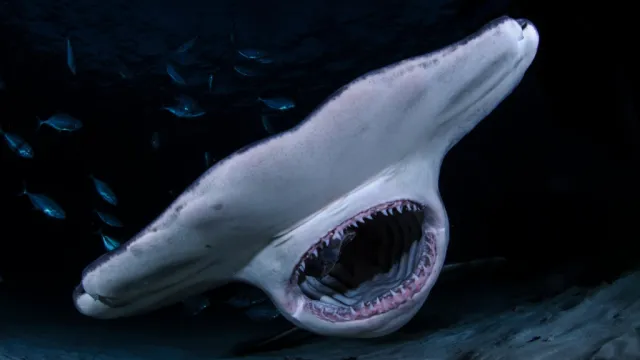
It's hard to think of creature more awesome, in a literal sense, than the shark. Rulers of the ocean, stars of blockbuster movies, and subjects of fascination for any proper-thinking person who gets excited every year when Shark Week comes around. To us, these majestic beasts vacillate between objects of petrifying terror or subjects of endless fascination.
But as much interest as they attract, there is much about sharks that the average person doesn't know. Those razor-sharp chompers hide a treasure trove of secrets and surprises—and yes, we went hunting for said treasure. Herein, you'll find the 50 most fascinating facts about our toothy friends. Some will endear you, while others are sure to send you scrambling for shore. And for more secrets from the seven seas, see the 30 Facts About the World's Oceans That Will Blow Your Mind.
1
Shark embryos attack each other.
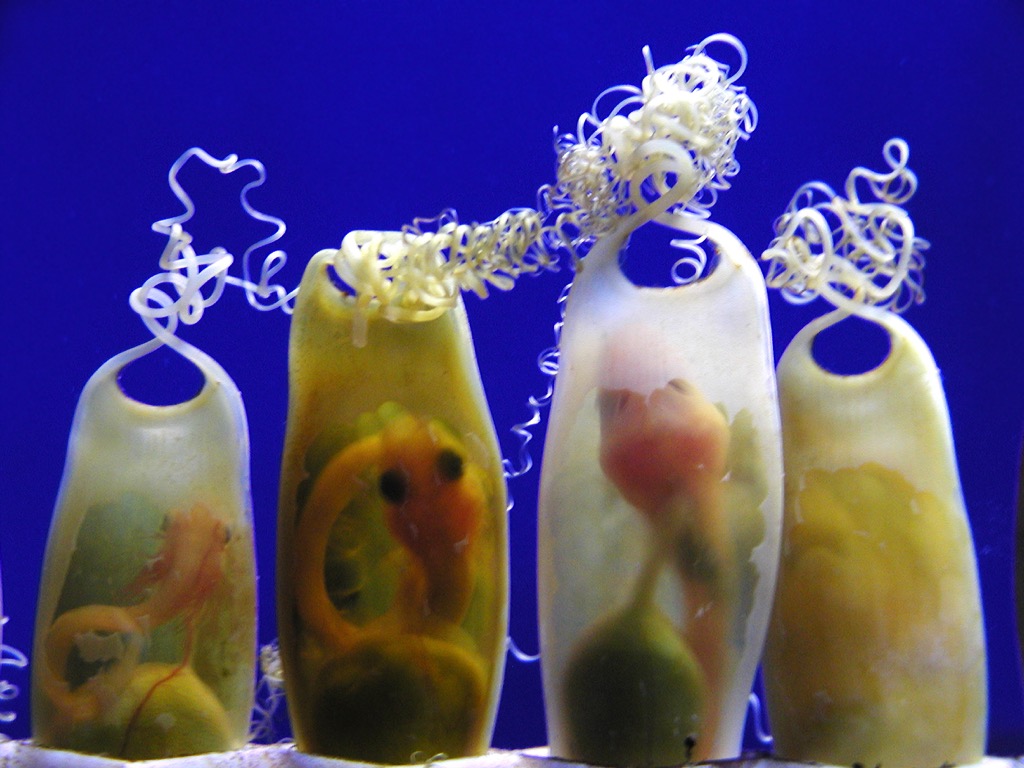
Sharks are so tough, their embryos are known to attack one another. The largest embryo in a shark litter is known to eat its fellow embryos, in an act known as intrauterine cannibalism. Researchers looked at this phenomenon in sand sharks, noting that, "While 12 littermates may start out the journey, all but one is devoured by the biggest in the pack. That strategy allows sand tiger sharks to have much larger babies at birth than other shark species, making the little ones relatively safe from other predators." And for more amazing trivia straight from the animal kingdom, don't miss these 40 Amazing Animal Facts.
2
Sharks have a sixth sense.

In addition to their killer sense of smell, sharks also can detect prey by tapping in to the small electrical fields that other animals generate using tiny organs called the ampullae of Lorenzini. These small pores, located near their nostrils, around the head and beneath their snout, are something of a second sight. The pores connect to long, jelly-filled bulbs that connect to nerves below their skill. And for more ways to maximize your ocean knowledge, check out the 30 Reasons Why the Ocean Is Scarier Than Space.
3
And it's strongest in hammerheads.
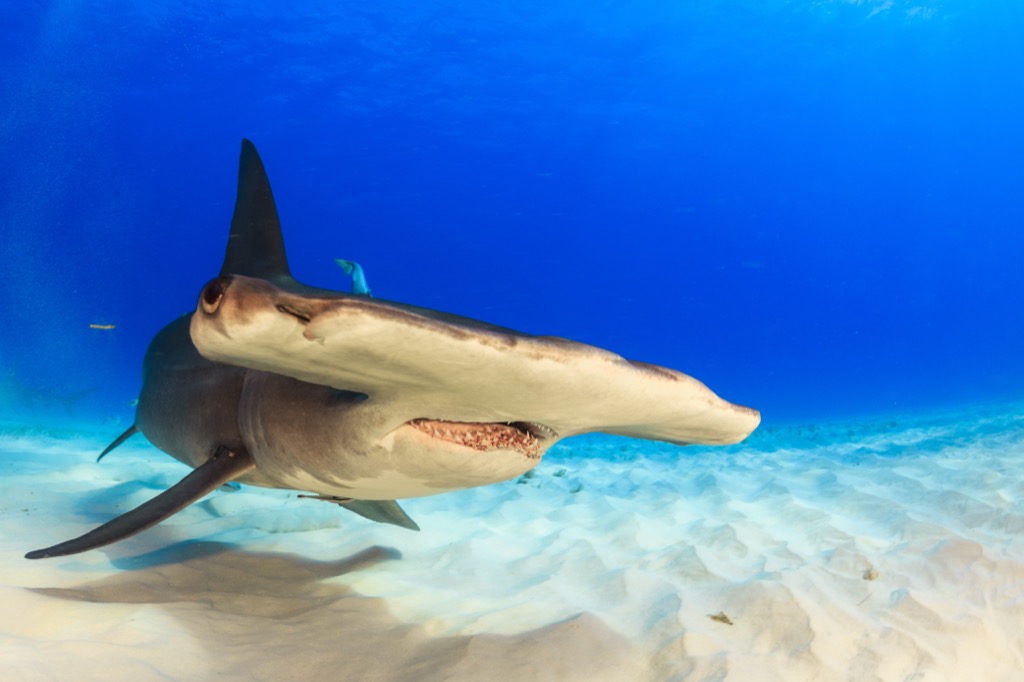
Hammerhead sharks have that funny-looking head for a reason. It contains a whopping 3,000 ampullar pores for picking up on electrical fields in the ocean. As MNN reports, "The hammerhead's increased ampullae sensitivity helps it track down its favorite meal, stingrays, which are usually hidden under the sand."
4
Hammerheads also have 360-degree vision.
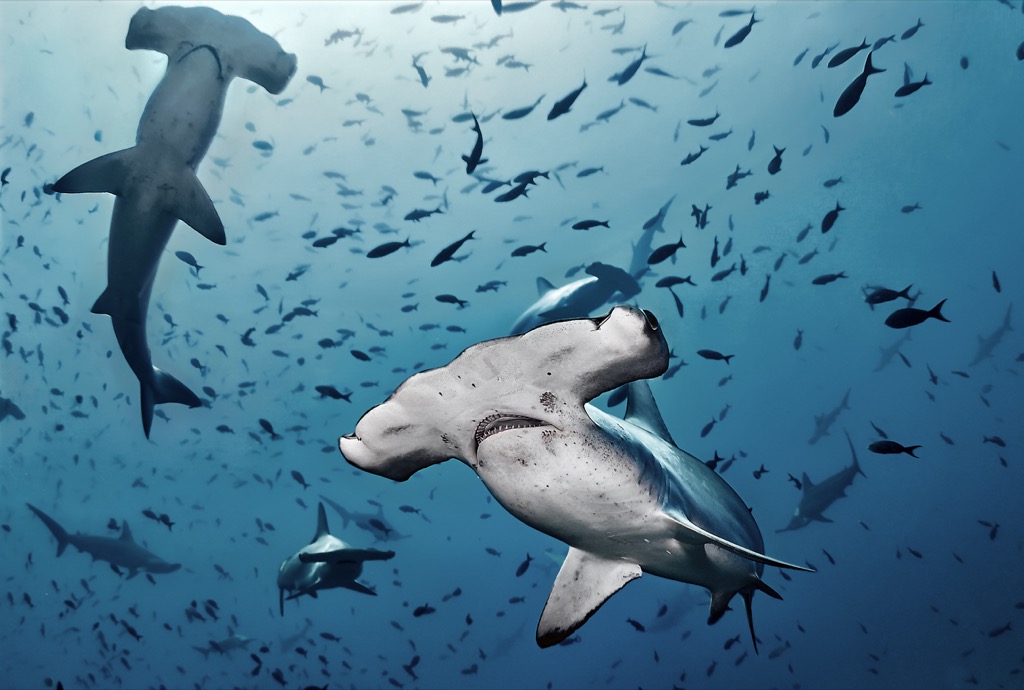
Another advantage of hammerheads' weird head is that they have incredible vision. A 2009 study found that the placement of their eyes gives them impressive binocular vision and the ability to see 360 degrees. "The eyes of hammerhead sharks are tilted slightly forward," as BBC Earth put it, "allowing the field of vision of each to significantly overlap."
5
The longest fish in the world is a type of shark.
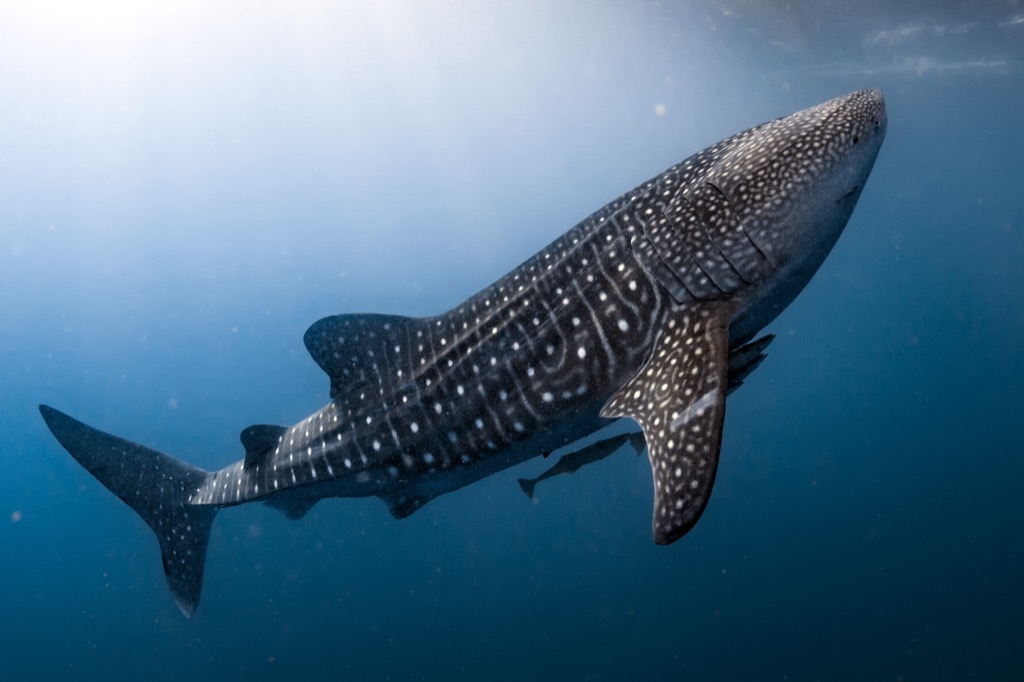
Reaching lengths of 40 feet long, the whale shark is seriously huge and holds the title of largest fish in the sea. But in the unlikely situation that you encounter one of these in the water, don't be alarmed: their main meal is plankton, which they eat by "filter feeding," in which they scoop up a huge amount of ocean water and scoop out the tiny plants and animals—it's tough to catch a person in that. And for more the seven seas, check out the 17 Floating Hotels That Are Simply Magical.
6
Female sharks generally dwarf male sharks.

Partly due to the fact that they need to carry shark babies, females tend to be larger in most shark species. And for more fun ocean facts, don't miss the 33 Missing Treasures Experts Say Are Real.
7
There are literal hundreds of sharks species.
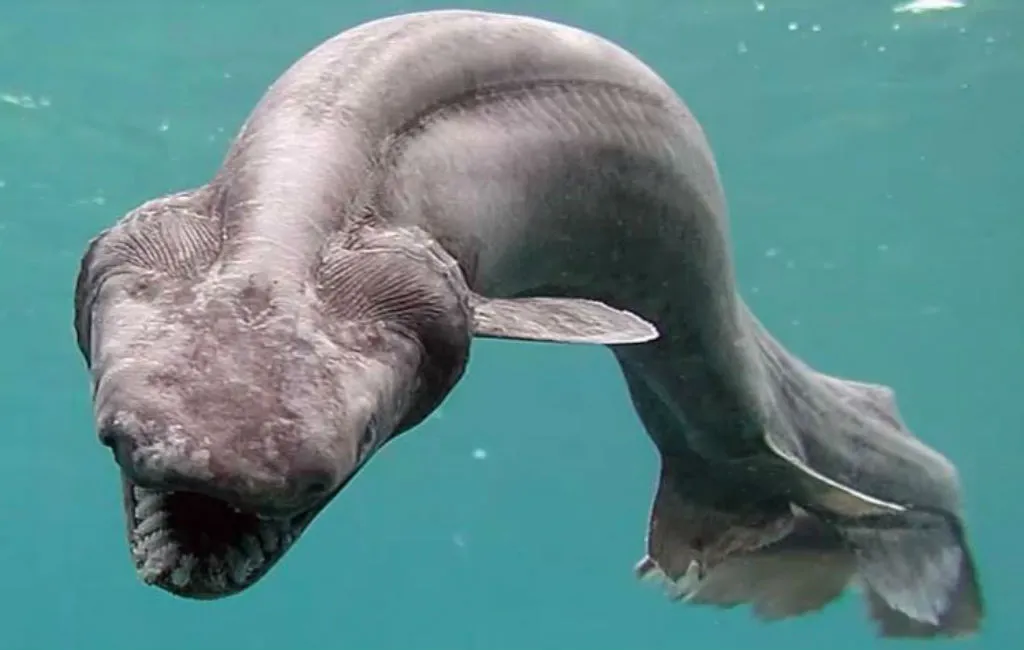
All told, there are almost 500 species of shark, including angel, bullhead, carpet, and dogfish sharks, not to mention weasel, mackerel, crocodile, zebra, and even cat sharks. They range in size from a few inches to 40 feet long, living in a wide range of habitats and boasting a strange assortment of physical characteristics.
8
No, not all sharks live in the ocean..
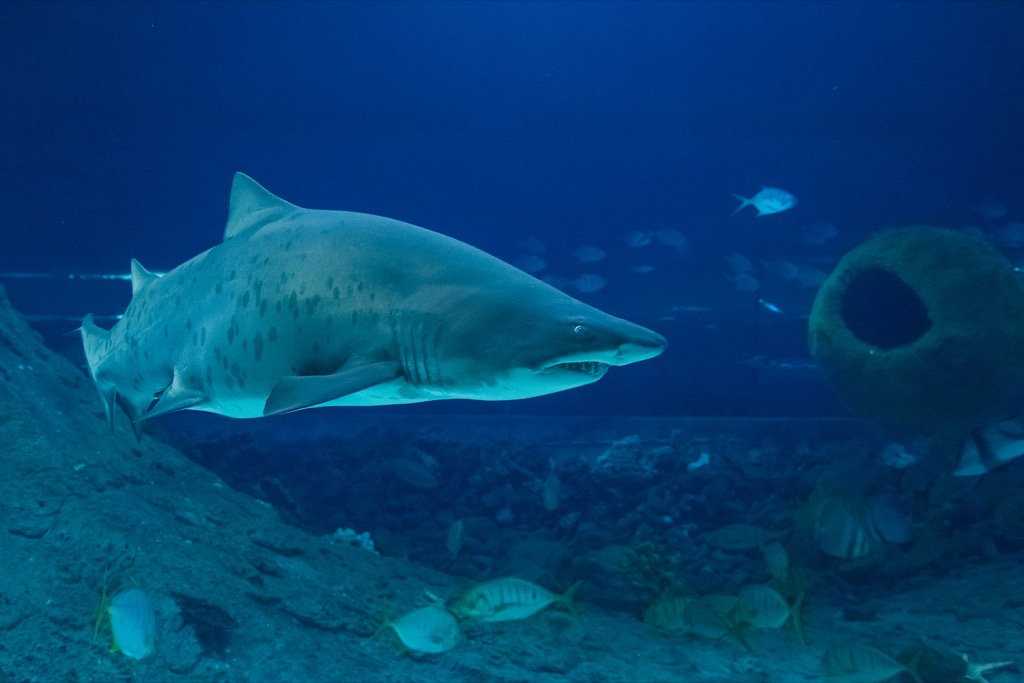
Just when you thought it was safe to go back into the lake… While sharks live in all of the world's oceans, a few species are also known to inhabit freshwater lakes and rivers. For example, bull sharks are found in tropical rivers and have evolved to swim between salt and fresh water. River sharks, true to their name, have been found in rivers in areas of South Asia, New Guinea, and Australia.
9
Some sharks are pregnant for two years.
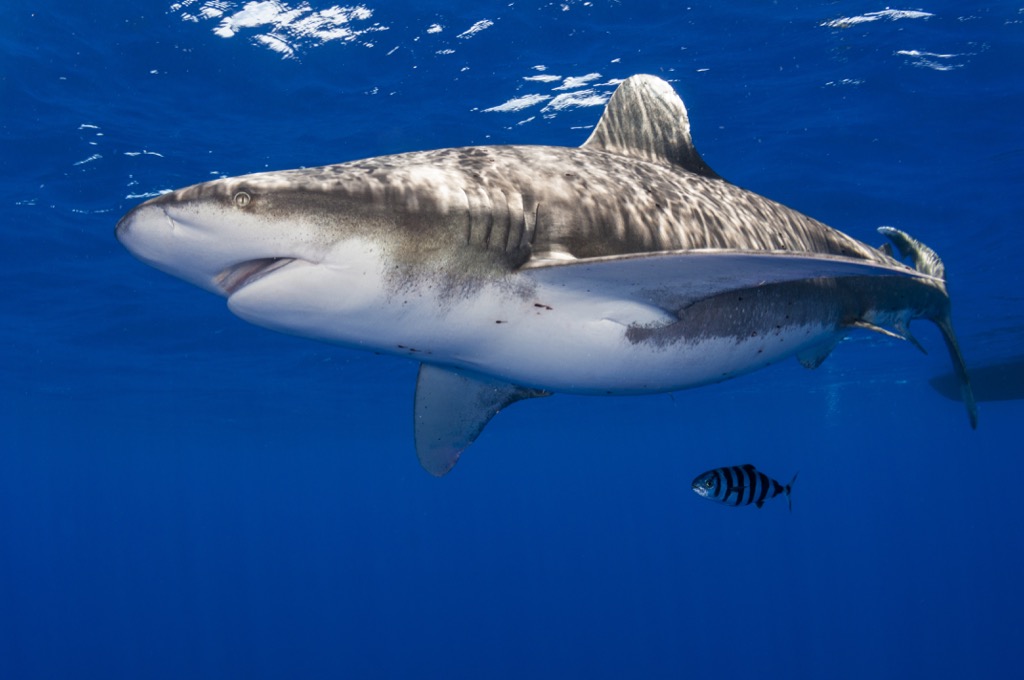
You thought nine months seemed like a while, but the spiny dogfish species of shark can take two years to gestate before delivery—making it the longest gestation period of any vertebrate.
10
Yes, you can ride a shark.

The largest species of shark is also one of the most easygoing. Whale sharks have been known to give a ride to hitchhiking swimmers, and cruise through the water atop them. But marine life experts caution against popularizing this sport. "When people spend a lot of time and a lot of pressure on a fish, it takes away that slime covering and potentially has negative health impacts for the fish," Marine biologist Bruce Neill told ABC News.
11
Great whites have a more powerful bite than jungle cats.

The jaws on the great white shark are no joke. A 2008 computer model estimated that a 21-foot great white would produce a force of almost 4,000 pounds per square inch (psi)—that's four times stronger than a tiger or lion, which were estimated to generate just 1,000 psi of force. Humans, who bite with around 150 to 200 psi, aren't even in the running.
12
But great whites don't have the toughest shark bite.

As fierce as they may be, pound-for-pound, great white sharks do not have the strongest bites in the ocean. A a study in Zoology revealed—researched measured the bite force of 13 different species of sharks—an eight-foot-long great white bites with 360 pounds of force, but a nine-foot-long bull shark has a bite force of 478 pounds.
"An 18-foot-long great white will still have a more powerful bite than an 11-foot bull shark, just by virtue of its size," the study's author told USA Today. "But pound-for-pound, a bull shark of the same size would have a stronger bite."
13
Bull shark jaws work like a vice.
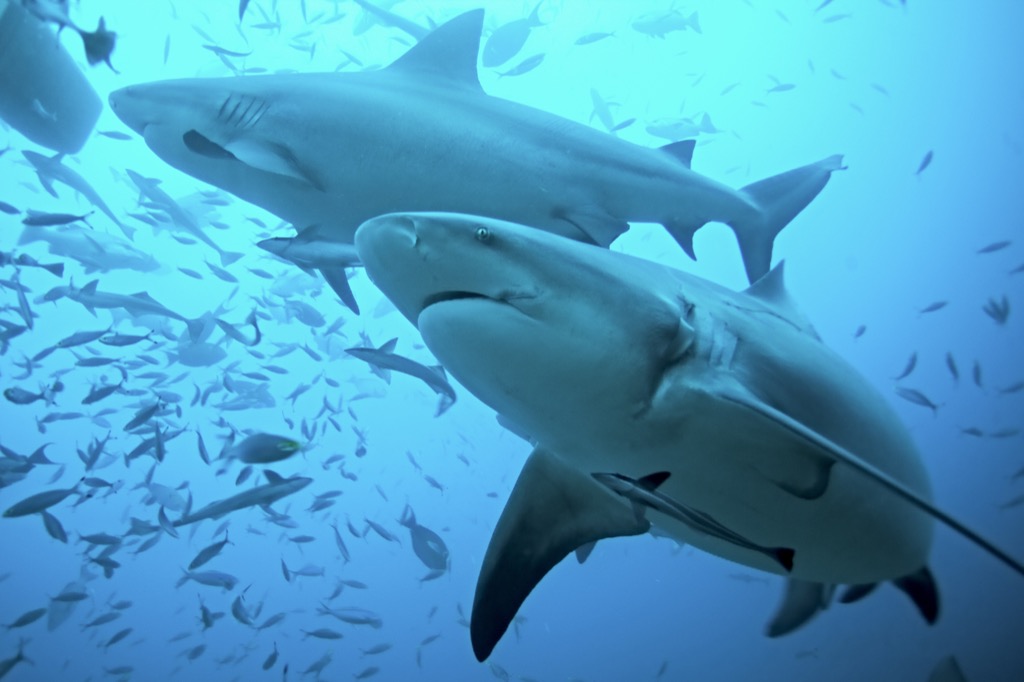
Part of the reasons bull sharks have such strong bites is that they feed in murky waters and have to hold on to their prey when they attack them (as opposed to those in clear water that can attack and reapproach repeatedly)—often taking on other sharks much bigger than they are.
14
Great whites do specialize in sneak attacks.

Great whites don't kill by crushing their prey in their jaws, they prefer a style of attack in which they chomp on their victim and pull back, letting the prey bleed to death before proceeding to eat the rest of them. For example, when attacking an elephant seal, a great white will immobilize it by taking a bite out of its hindquarters and retreating, returning once it's died and won't struggle.
15
Lightning strikes are more deadly than shark attacks.

Despite what Jaws would have you believe, it's seriously unlikely you will be attacked by sharks. Like airplane crashes, when they do happen they get a lot of publicity. As National Geographic points out, "The U.S. averages just 19 shark attacks each year and one shark-attack fatality every two years. Meanwhile, in the coastal U.S. states alone, lightning strikes and kills more than 37 people each year."
16
Hippos, deer, and cows are more deadly than sharks, too.
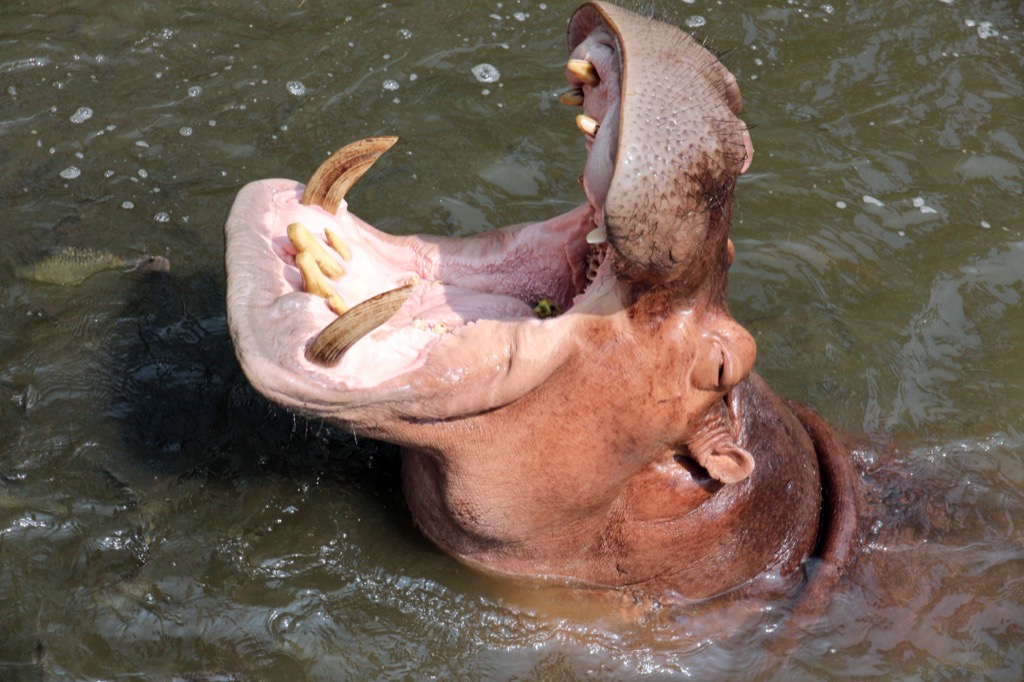
There are plenty of animals that are far more dangerous than sharks. While sharks kill an average of less than one person a year in the U.S. and less than six worldwide, the stats are much scarier for creature such as hippos (which kill a reported 2,900 people in Africa annually), deer (which are responsible for the deaths of an average 130 people per year, usually due to car collisions), and cows (which kill about 22 people a year).
17
You've probably eaten shark.

You probably don't think you've ever eaten shark, but if you've been traveling in Europe and are a fan of drunk food, there's a decent chance you have. According to the Monterey Bay Aquarium, "Spiny dogfish are not in demand as a food item in the United States, but they're popular on the international market. If you order 'fish and chips' in Europe, for example, you'll probably be eating spiny dogfish shark meat."
18
Female sharks can be impregnated by multiple partners at once.
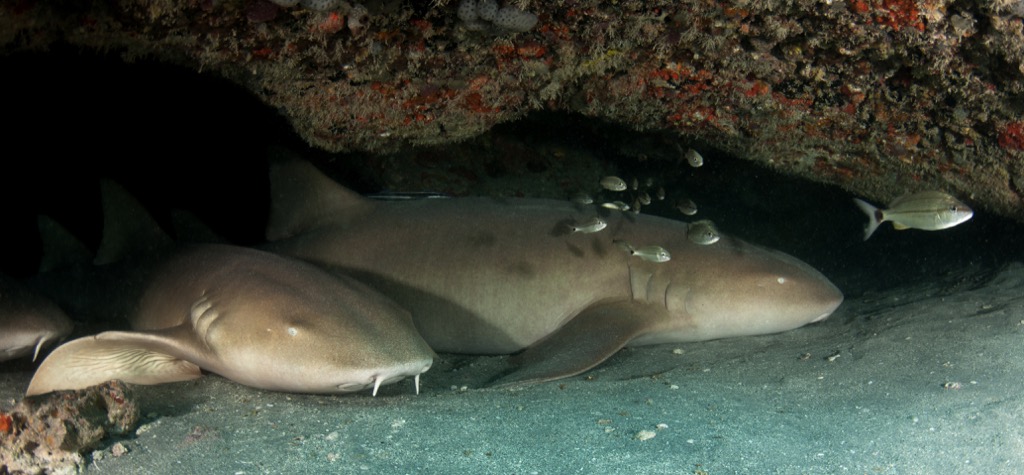
Female sharks have been known to use the sperm from multiple males when they reproduce—meaning that pups they give birth to at the same time may be just half-siblings. In one study, 36 percent of the litters looked at were fathered by two males instead of one.
19
Female sharks can reproduce without male sharks.
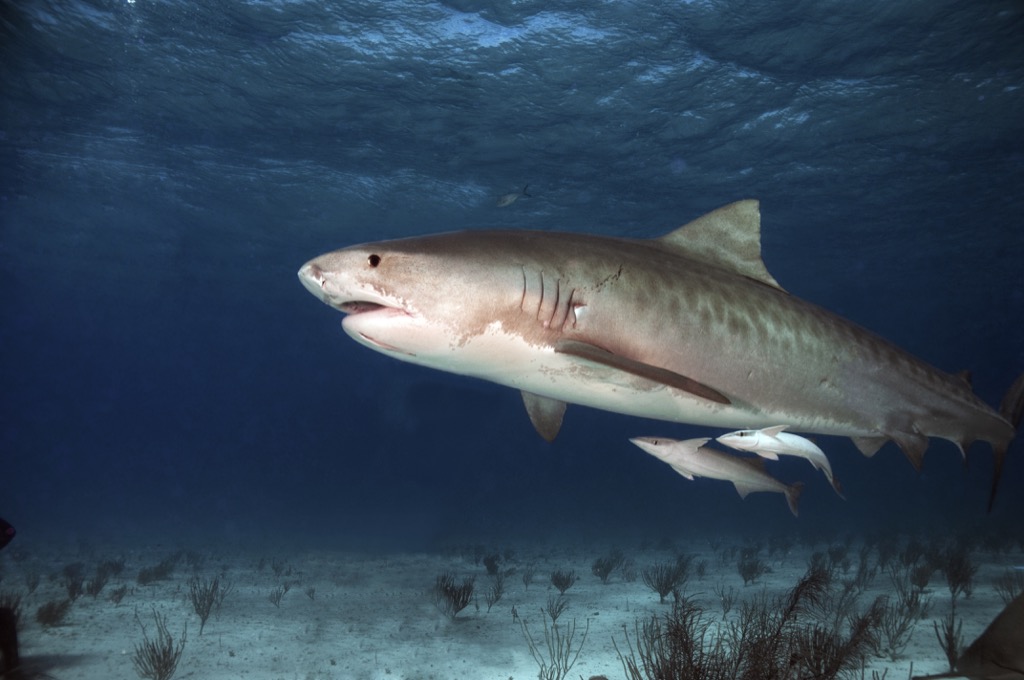
Female sharks are so awesome, they don't even need a guy to reproduce at all. At least that was the case with one zebra shark (named Leonie), who was separated from her mate for four years in an Australian aquarium—but somehow still gave birth to three baby sharks in 2016. "One possibility was that Leonie had been storing sperm from her ex and using it to fertilize her eggs," according to New Scientist. "But genetic testing showed that the babies only carried DNA from their mum, indicating they had been conceived via asexual reproduction." In another case, a hammerhead shark gave birth in a Nebraska aquarium without mating at all.
20
Sharks prefer to attack men.

According to National Geographic, of all documented shark attacks since 1580, 93 percent have been made on males. This is likely due to the fact that the most common victims of shark attacks are surfers, swimmers, and fishermen, who are more often male than female.
21
Tiger sharks will eat anything.
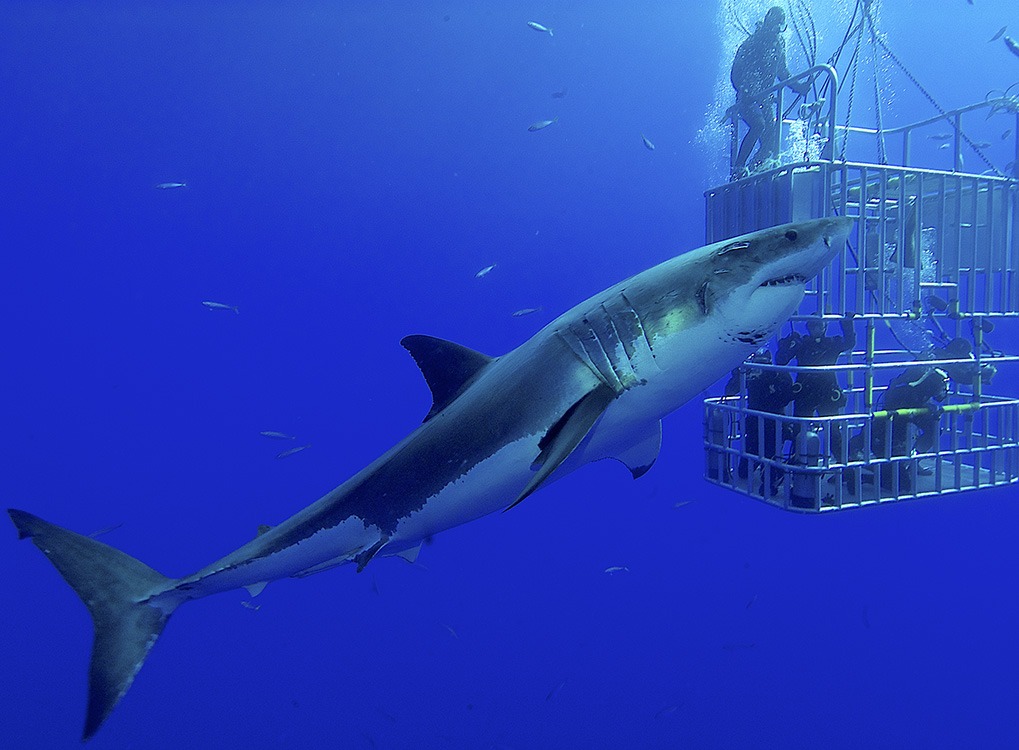
This species of shark has earned its nickname, eating pretty much anything it can get its jaws around. Among the odd objects that have been discovered in the stomach of these animals: license plates from almost every U.S. state, video cameras, dog leashes, a bag of money, birth control pills, and other sharks.
22
Shark litters are enormous.
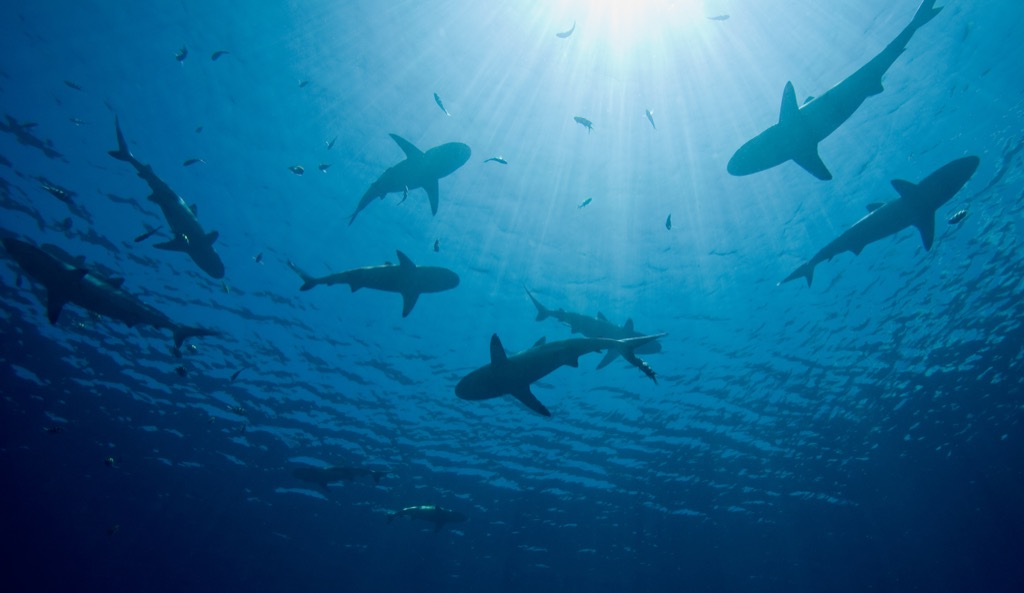
While the number of pups birthed in a litter varies widely depending on the species, some sharks can give birth to huge litters. For example, the blue shark is known to give birth to as many as 135 pups in a single litter.
23
Their skeletons aren't made of bone.

Seriously. Sharks' skeletons are made of pure cartilage and muscle. Since it's half the density of bone, this makes the shark lighter and more flexible, which comes in handy when its pursuing prey and having to make sharp turns.
24
They don't sleep. At all.
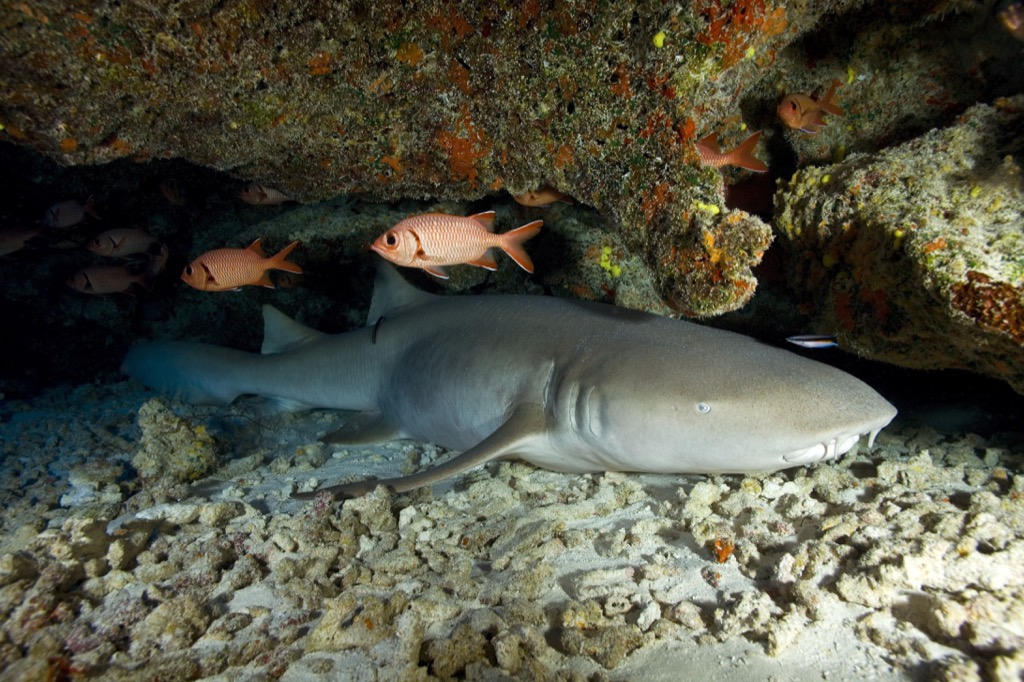
At least, they don't sleep like humans. Since some species have to continue swimming in order to breathe, instead of falling into a deep sleep, sharks remain semi-conscious.
25
Sharks are older than dinosaurs.
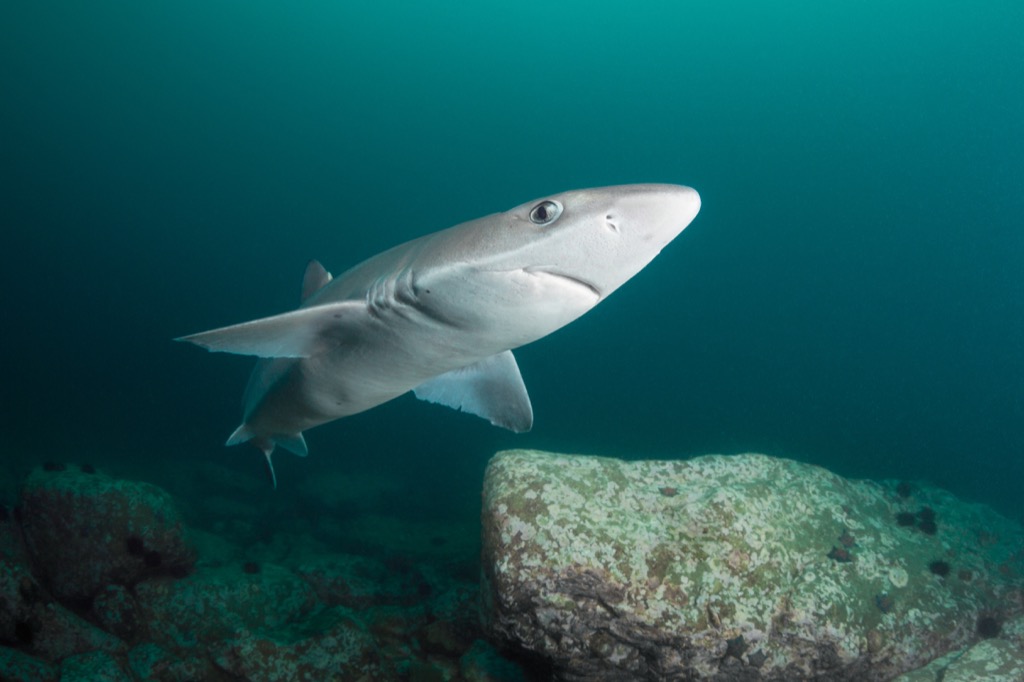
Sharks have been around for a long, long time—about 450 million years, according to scientific estimates. The animals go back to the late Silurian period when coral reefs were first beginning to form. "Jawed and bony fish began to diversify, including the evolution of a group of fish called acanthodians, or 'spiny sharks,'" explains the BBC. "These extinct fish looked like small sharks but had varying numbers of fins."
26
Sharks used to be bigger than buildings.
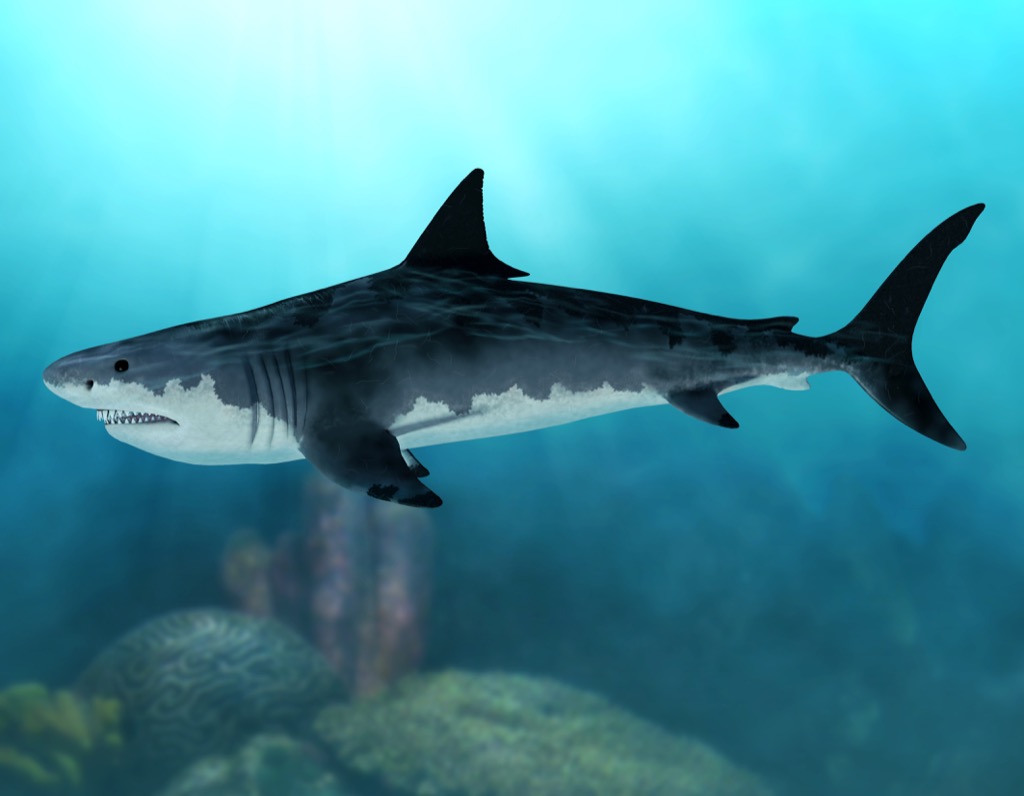
As huge as some sharks may be, their ancestors are even more impressive. For example, the Carcharodon megalodon, which first appeared about 16 million years ago, grew to 55 feet long and weighed as much 25 tons, before going extinct about 2.5 million years ago, making it the largest predator that ever lived, eating dolphins, whales, and other megalodons.
27
A great white is about the size of a megalodon's…
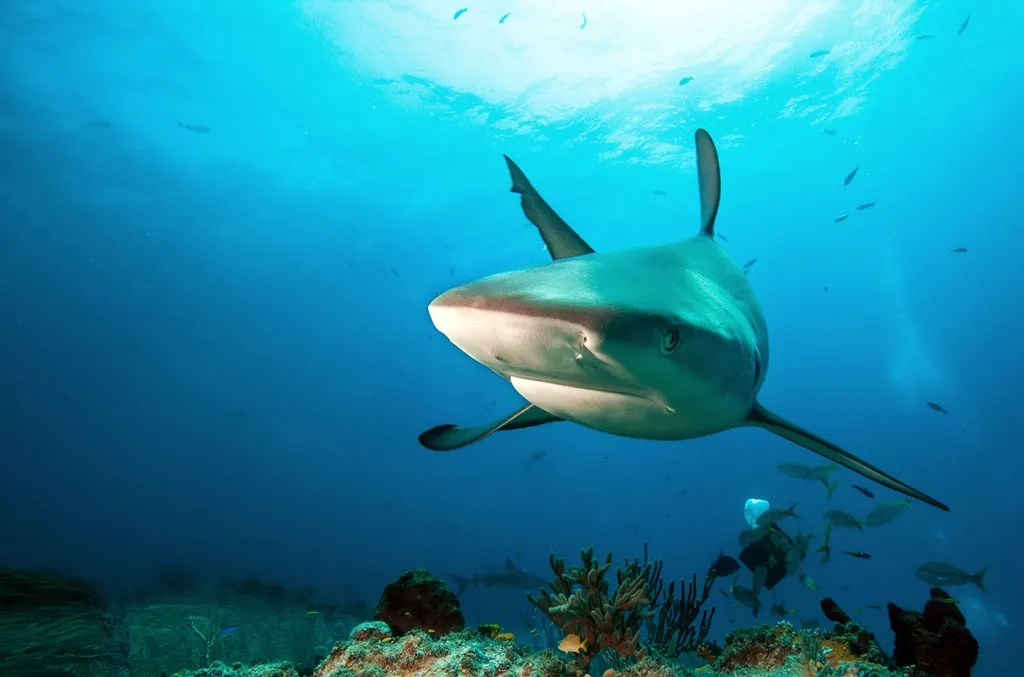
Well, private parts. Peter Klimley, a shark expert at the University of California at Davis, told National Geographic that, "A great white is about the size of the clasper, or penis, of a male Megalodon."
28
Megalodons sparked some media controversy.

The fascination around these legendary creatures earned some backlash for the Discovery Channel in 2013 when it aired a mockumentary with actors pretending to be scientists discussing the long-extinct animals as if they still existed. Though the channel included a disclaimer before and after the two-hour special, it still drew complaints on Twitter and from the scientific community who disapproved of the disinformation, even if meant as innocent fun.
29
Sharks have (way) more than one series of teeth.
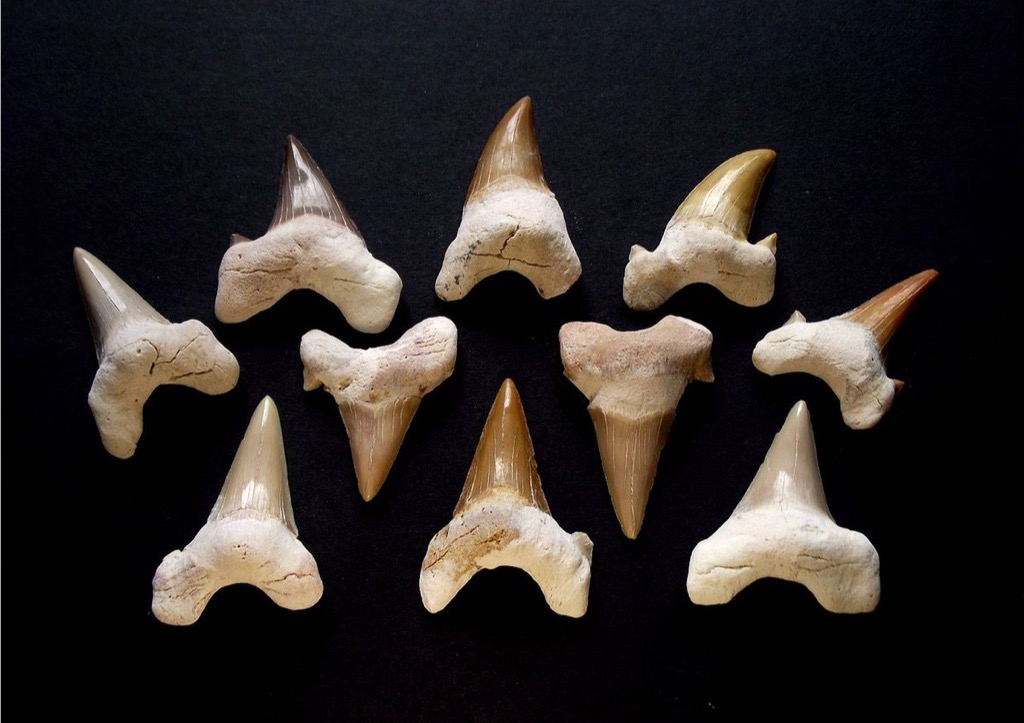
Though exact numbers vary by species, sharks can have up to 15 series of teeth in each jaw, with one line after the other going from largest and most functional up front back to smaller and less powerful.
30
Sharks grow up to 50,000 teeth in a lifetime.

The series of teeth toward the back of the shark's jaws also serve as replacements for the teeth up front when they are damaged or lost, in what might be called a "conveyer belt of death" (shark teeth are not deeply rooted in the way human teeth are, making this a pretty common occurrence—and also means its teeth are almost always in pristine condition).
31
The ocean floor is a graveyard for shark teeth.
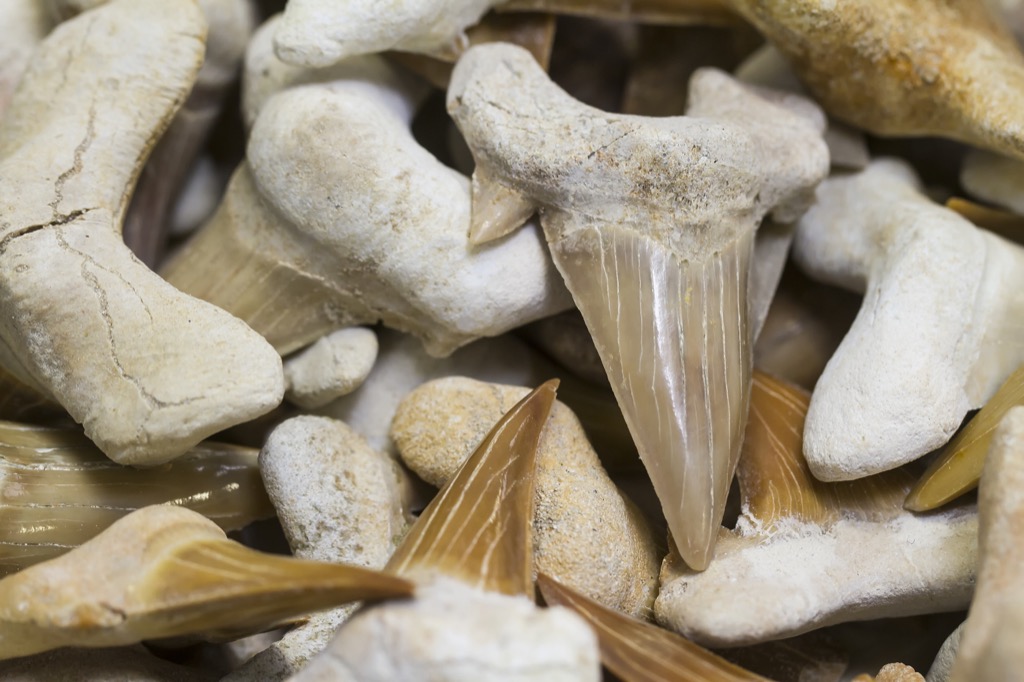
Because sharks are constantly losing and replacing teeth, experts say there are trillions of teeth sprinkled on the ocean floor, there for deep-sea divers to discover and turn into weird jewelry.
32
Yes, sharks have scales.
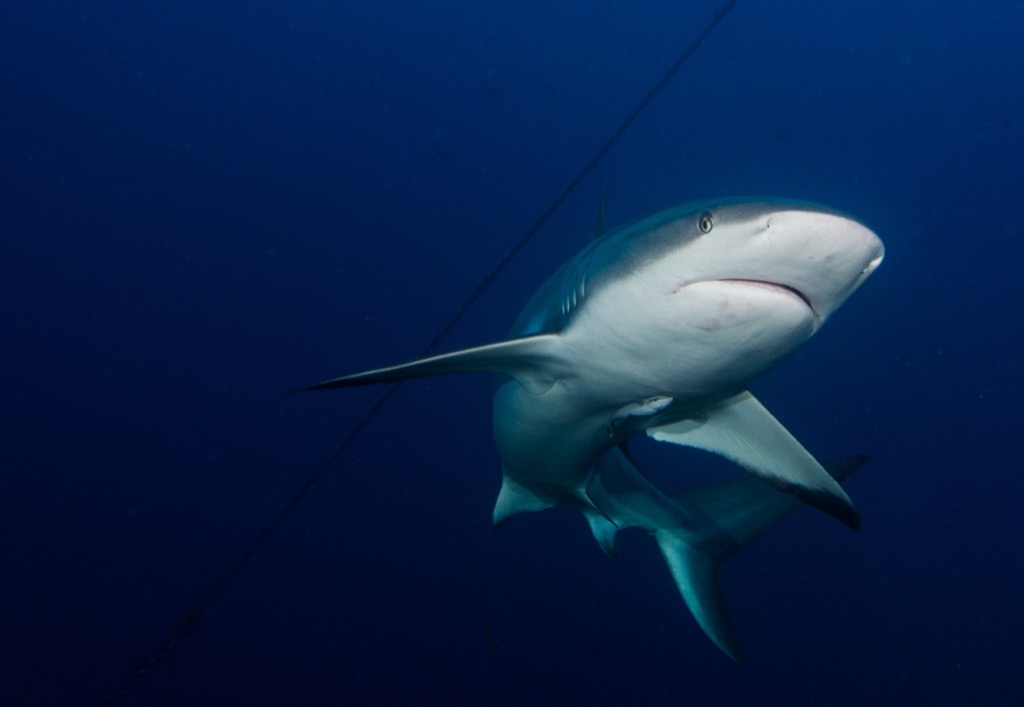
As if they didn't have enough teeth already, they also have "dermal denticles," or tooth-like scales on their exterior. These don't get larger as the shark ages, but instead the fish grows additional scales that fill in the gaps as needed. Each is covered with a substance called vitrodentine similar to the enamel that covers our teeth (their actual teeth are in fact modified versions of these scales).
33
Sharks can be as small as a goldfish.
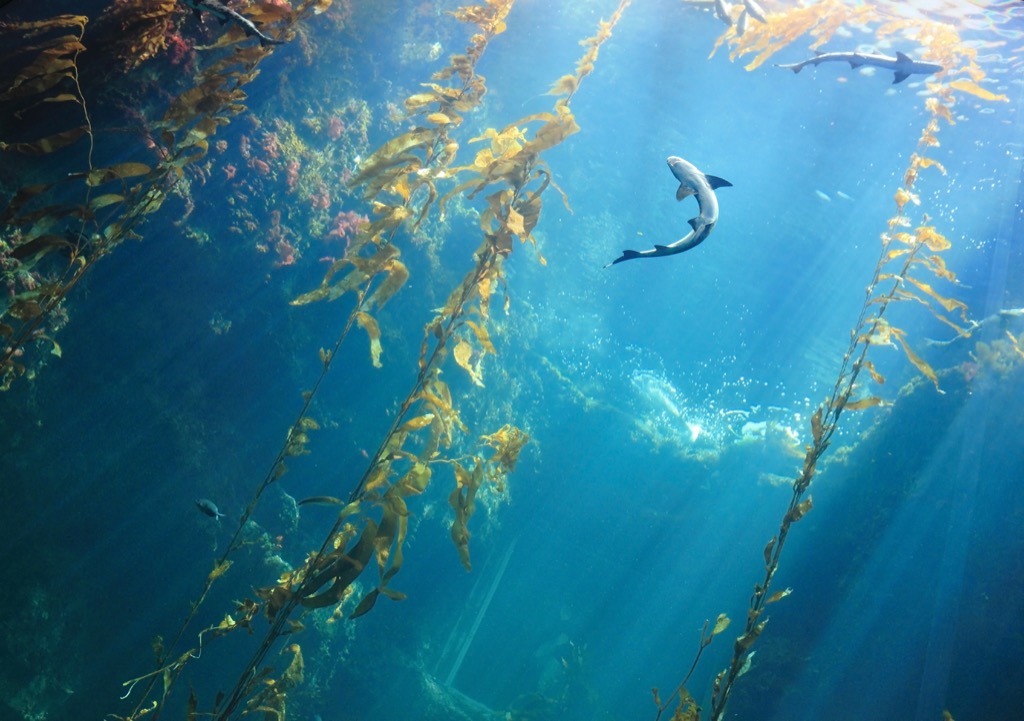
The dwarf lantern shark is hardly one of the fierce creatures you picture when you hear the word "shark." This odd animal, found near the northern coast of South America, grows to just six inches in length. But what it lacks in size it makes up for in other quirks: its organs emit light along its belly, helping to camouflage it in the rays of sunlight that stream into the shallow water it inhabits.
34
Great whites have a keen nose for blood.
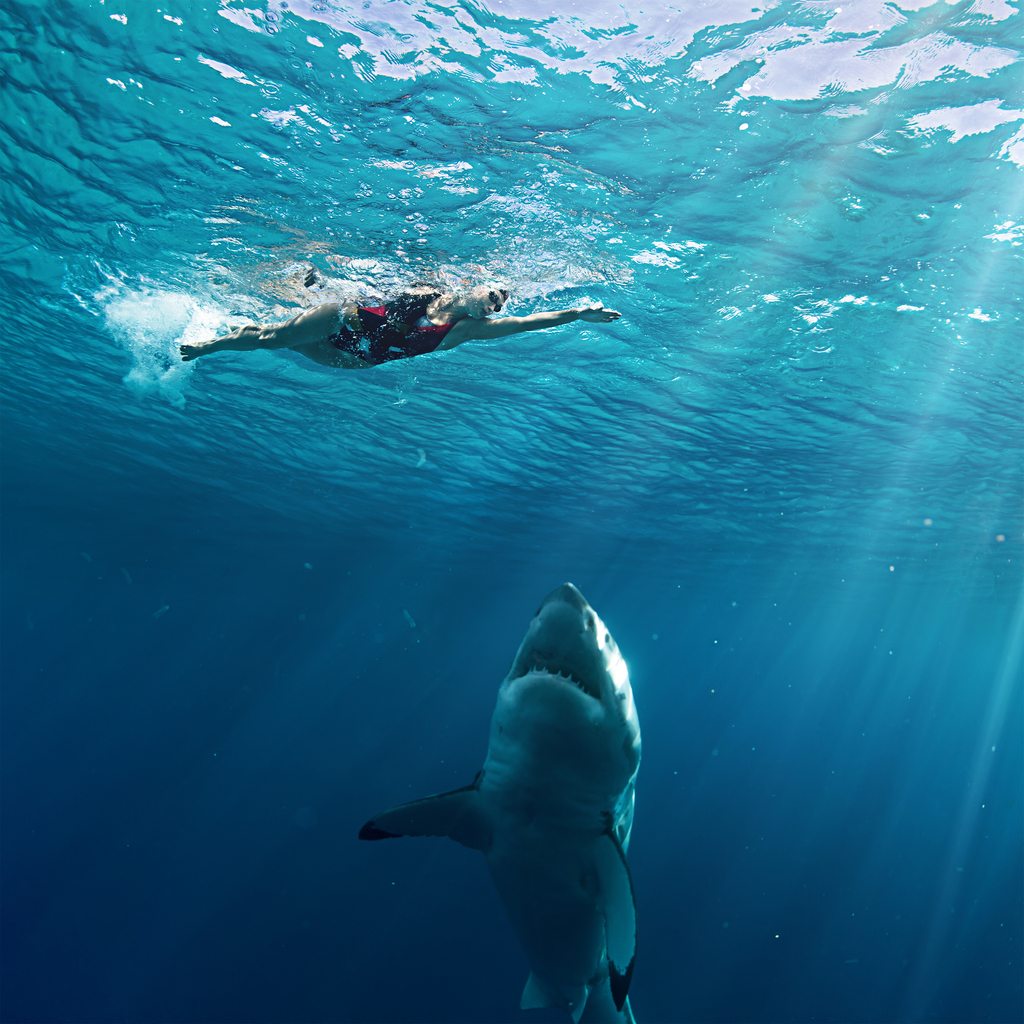
Great whites' famously powerful sense of smell comes from its giant olfactory bulb, an organ that connects to its nostrils and allows it to detect prey with impressive sensitivity. But don't believe it when someone tells you they can smell a single drop of blood in all the ocean—they can only detect blood up to one part per 10 billion (or, a drop in an Olympic-sized pool).
35
Shark embryos can sense danger.
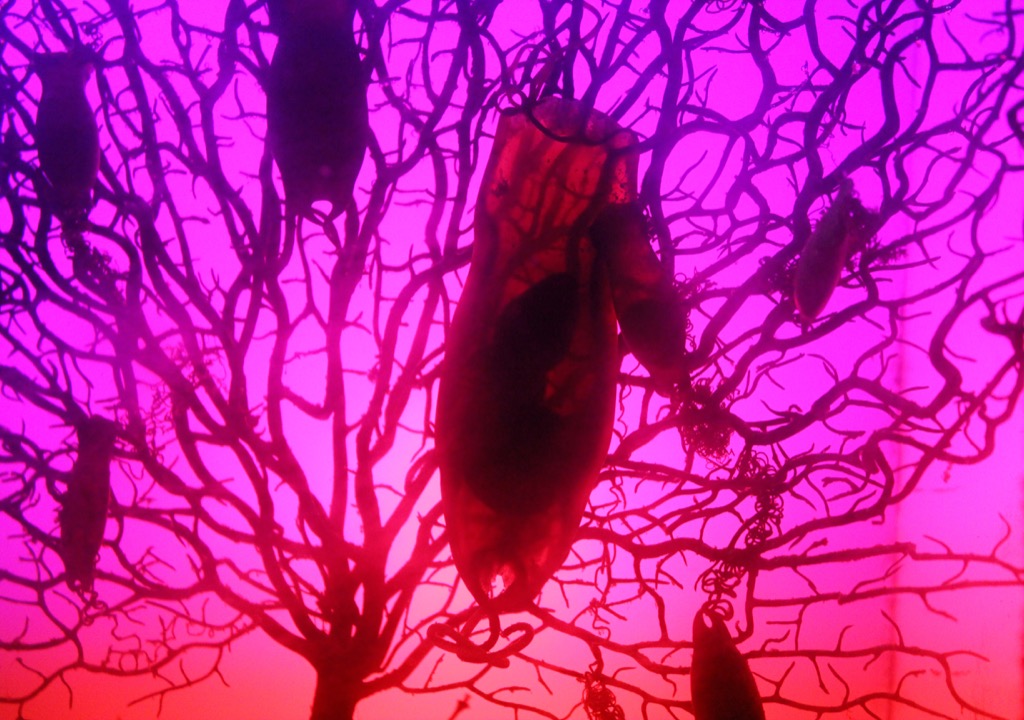
Sharks are pretty smart right before they're even born. Shark embryos have been found to deploy a similar electrical receptor as adult sharks do when sensing prey or avoiding predators. When researchers imitated a predator using electric fields, the embryos of brown-banded bamboo sharks, contained in an egg case, slowed their gill movements to avoid detection.
36
We have more in common with them than you'd think.

Since both humans and sharks are jawed vertebrates, we share a common ancestor, believed, according to Nature, to be the Acanthodes bronni. We began developing on our own, very distinct, evolutionary paths more than 420 million years ago, but connections remain. For example, an analysis of the genes of great whites found greater similarity between its genes associated with metabolism and those of humans than those of zebrafish.
37
There's a shark that's 120 million years old.

While megalodons are long gone, there is a species still around that was alive long before the megs—the goblin shark, a pink-skinned fish with a crazy-looking long and flat snout. The animal grows to around 10 to 13 feet and length and keeps deep underwater, near the ocean floor. It's so old, it's been classified as a "living fossil."
Image via Wikimedia Commons
38
A shark's vertebrae tells you its age.

Just as the rings of a tree tells you how many years it's lived, scientists usually determine the age of most species of fish by counting the "rings" on small calcium structures in their ears. But since this doesn't work as well on sharks, according to Smithsonian, "Recently, scientists have been using a new method of determining shark age: by using a radiocarbon timestamp found in the vertebrae of sharks left over from nuclear bomb testing in the 1950s and 1960s."
39
Sharks have incredibly acute hearing.

While sharks' ability to smell is well known, their hearing is at least as equally impressive. They are able to hear their prey as far as 3,000 feet away, hearing low-frequency sounds, like that made by a struggling fish's contracting muscle tissue.
40
Sharks heat their eyes.

Sharks that are part of the Laminid group (including great whites, mako, and porbeagle sharks) are able to have a special retina that warms their eyes and brains, which helps them to better detect movement and improve resolution on the images that they see. As WildAid explains, "For mako sharks, who travel vertically and come across very different temperatures in a short time, the retained warmth is especially important to keep the eyes and brain stabilized."
41
Sharks move both the top and bottom jaws.

Unlike humans who can only move their lower jaw around, sharks can freely move both their upper and lower jaws, detaching when it attacks its prey, allowing it to better grip the unfortunate animal and chew it up.
42
The skin on whale sharks is six inches thick.

Whale sharks are essentially bulletproof, with six-inch-thick skin. Though it's not the thickest in the animal world (sperm whales have skin measuring more than a foot thick), but it's tough enough that it's made it extremely difficult for scientists to get a blood sample of the creature.
43
Some give birth to fully grown offspring.
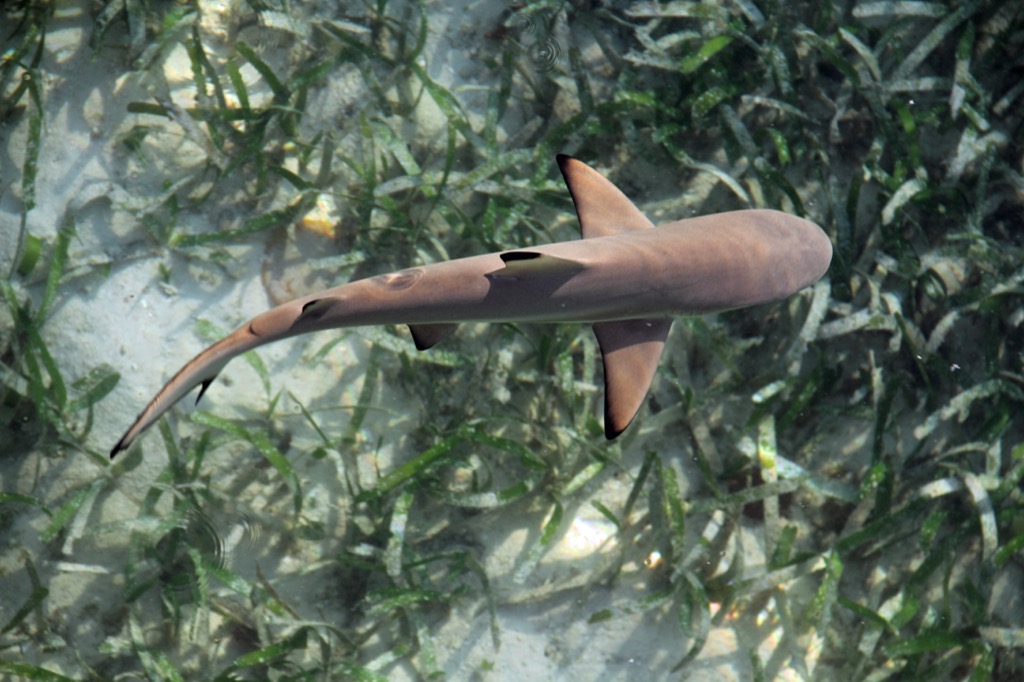
While most bony fish produce eggs that are hatched outside the female's body, shark pups are fertilized and hatch within the female body, leaving their mother's body fully formed.
44
Baby sharks are born with all of their teeth.
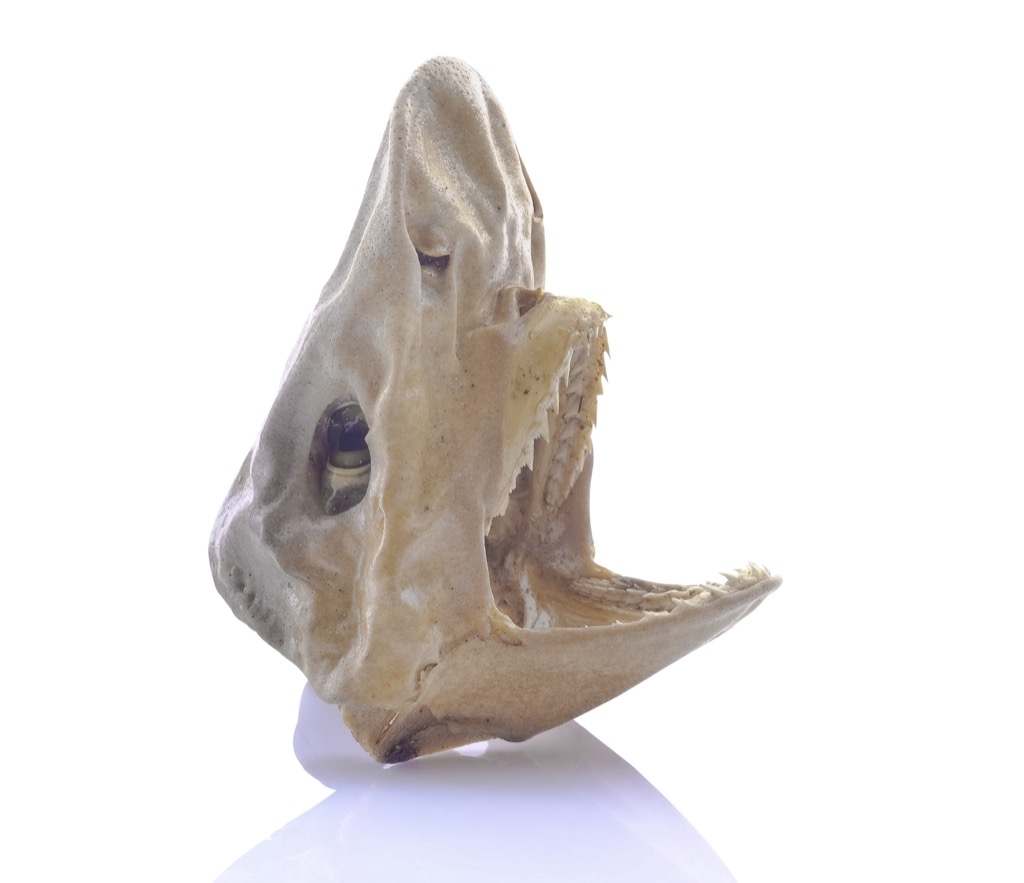
That full formation extends to the teeth of baby sharks, with shark pups entering the world with a full set of teeth intact and ready to fight off threats—including their littermates and own mother.
45
Sharks mate at their birthplace.
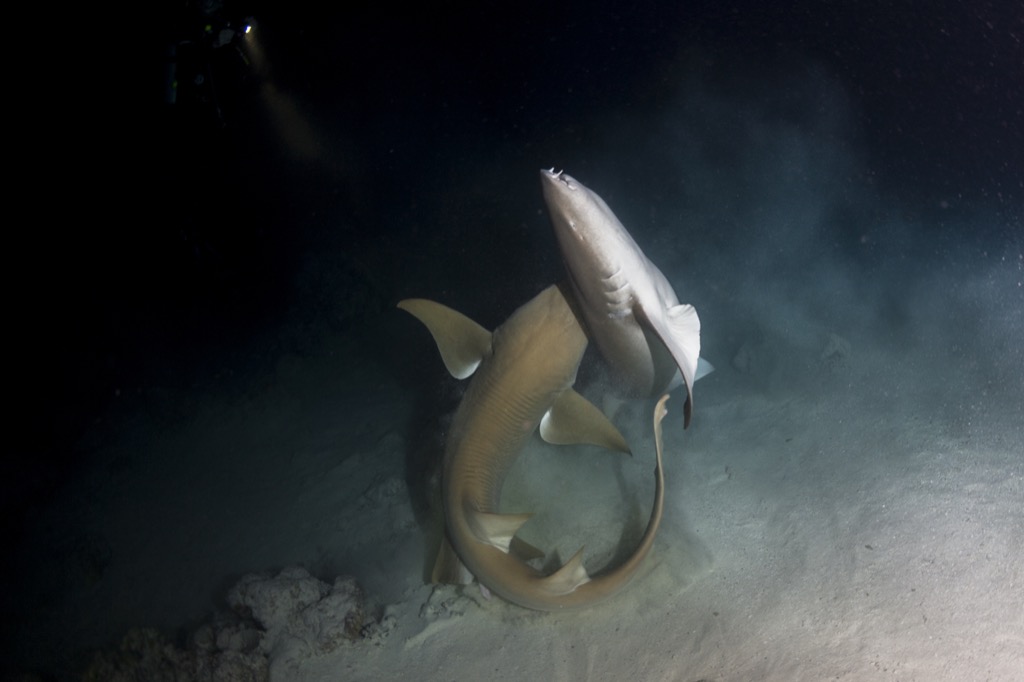
Sharks stay true to their roots. A 19-year study of lemon sharks, in which babies were tagged, released and tracked, found that a number of them returned to the same site where they were born years earlier so that they could then give birth.
46
Sharks move unimaginable distances without rest.

Due to their unusual sleeping style, sharks can travel nonstop for days, with great whites known to go distances of 2,500 miles or more without taking a pause for resting or eating.
47
They can survive thanks to liver oils.
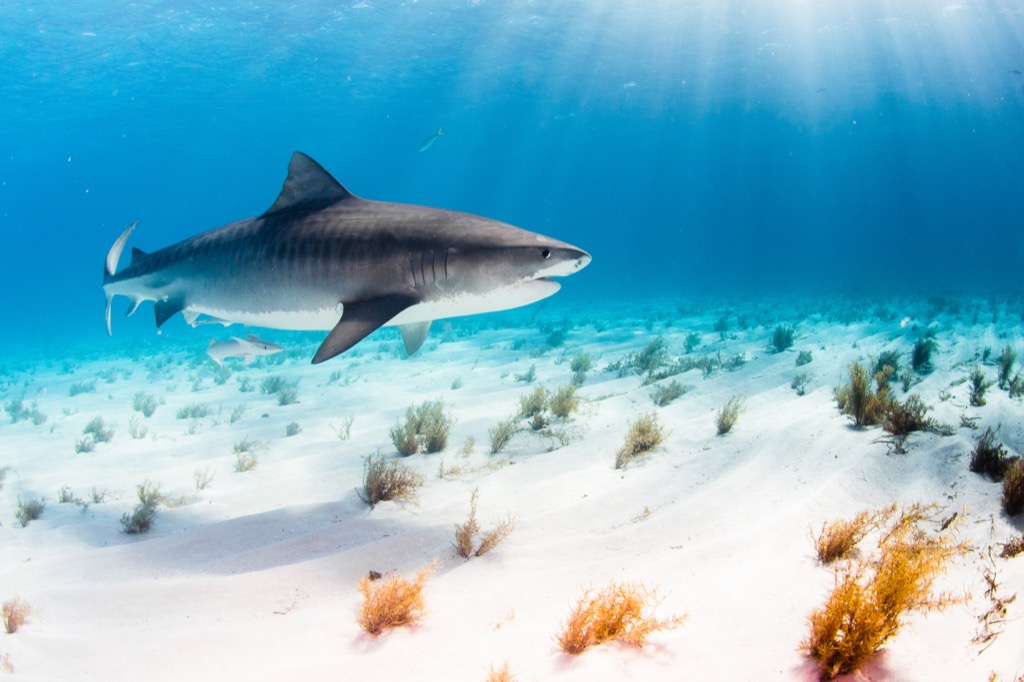
Sharks manage to avoid stopping to eat by drawing on fat stored in their livers (organs that account for as much as a quarter of their body weight). Researchers have found that the oil depleted consistently over time as they migrated.
48
Shark skin makes them fast.

The tooth-like design of shark scales helps streamline their bodies and allow for speedier movement through water. Not only does it reduce drag, it shifts the flow of the water that surrounds them, helping propel them forward.
49
Sharks are silent.

Sharks do not have vocal chords and do not use audible sounds to communicate anger or other emotions. Instead, they express themselves physically. As shark expert Peter Klimley (otherwise known as Dr. Hammerhead) explained to NOVA, "Female hammerhead sharks do chase smaller and less strong sharks from the center of schools by performing a threat consisting of reverse flip and full twist in diving parlance."
50
Their biggest threat is humans.
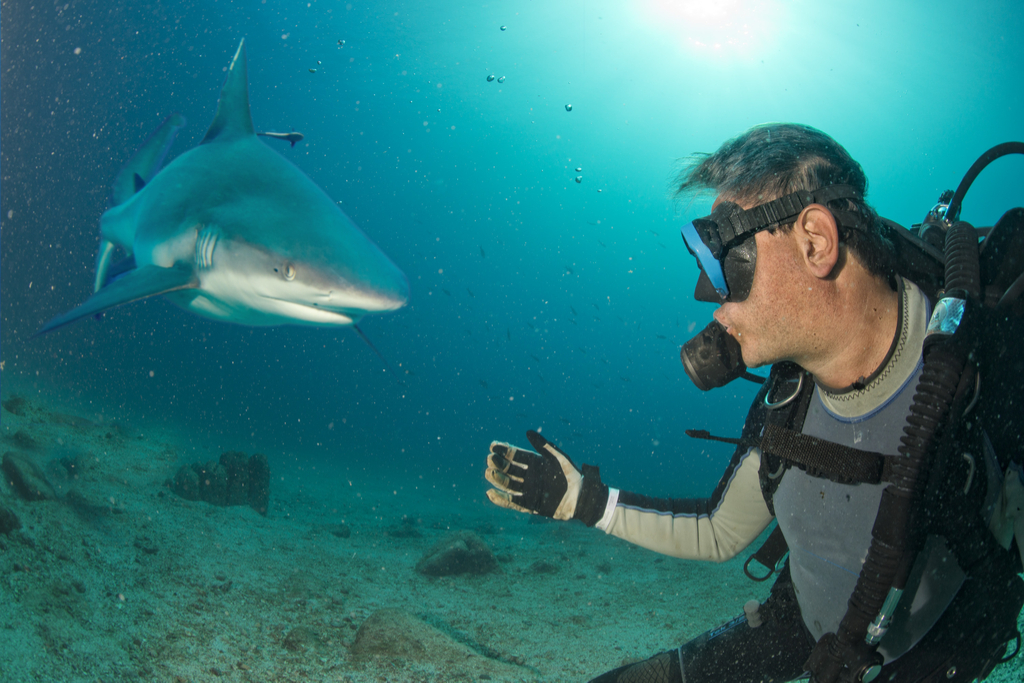
Sharks don't really have natural predators. Though killer whales, crocodiles, and other sharks will sometimes eat sharks, "Humans are by far the greatest enemy of sharks," according to shark biologist Samuel Gruber. According to a 2006 study, some 73 million sharks are killed by humans each year. So if anything, sharks have far more reasons to fear us than vice versa. Next, don't miss the 20 Bizarre Sea Creatures That Look Like They're Not Real.
To discover more amazing secrets about living your best life, click here to sign up for our FREE daily newsletter!





















